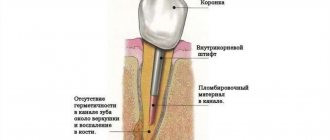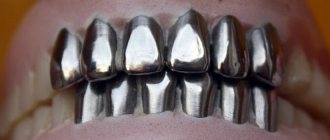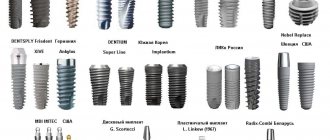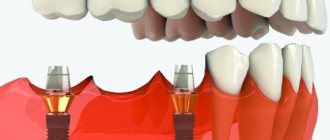Filling using the lateral condensation method is a common dental procedure that allows you to quickly and cost-effectively eliminate root canal pathologies. Its essence lies in the use of gutta-percha pins and endosealant, which fills the empty space between the tooth tissues and the pins, which creates high-quality, uniform protection of the root canal.
The lateral condensation method can provide complete coverage of the root canal in almost all cases, with the exception of highly curved and narrow canals with a pronounced violation of the anatomical shape. The method is used in more than 80% of dental restoration cases in Western European countries.
Treatment Goals
During endodontic treatment, the dentist must achieve certain goals. Only after achieving them can you count on a quality result.
Main goals of treatment:
- Complete mechanical cleaning of dental root canals from damaged tissues, bacteria and the results of their reproduction;
- Complete closure of root canals in all directions.
Thanks to high-quality cleaning, the destruction of healthy dental tissues is stopped. Clogging the canals helps protect the roots from re-infection with bacteria and destruction.
Suitable materials are required for complete sealing. The seals must meet the following requirements:
- Do not cause irritation to surrounding tissues;
- Ensure tight sealing;
- Protect against bacteria and prevent their penetration into the root canal.
The most suitable materials for such purposes are gutta-percha (dense pin) and sealers (cement layer). When used together, they make it possible to obtain a hermetically sealed inert seal.
Gutta-percha is a unique natural material. Thanks to its homogeneous structure and thermoplastic properties, it is possible to obtain a homogeneous filling suitable for any shape of the root canal.
The sealer further enhances the strength of the filling by sealing the spaces between the walls of the root space and the gutta-percha.
The properties of the main materials of the filling allow it to perform the following functions:
- Complete sealing of the root and its branches;
- Matching the root canal configuration;
- Protection against bacteria;
- Creating a favorable environment for the regeneration of root tissues.
Glossary of the video “Lateral condensation technique: 30 steps”
For those who want to improve their “dental English”.
| MAC (master apical cone) | master pin |
| accessory cone | additional, auxiliary pin |
| tug-back effect | checking the tightness of contact between the master shift and the canal walls at the apex (effect of resistance to pulling) |
| paper point | paper point (for drying root canals) |
| spreader | spreader, expander |
| apical pressure | pressure towards the apex |
| CEJ (cement-enamel junction) | CES, cement-enamel junction |
| pulp chamber | crown cavity, pulp chamber |
General idea of the methodology
The technique of vertical condensation of gutta-percha was originally described in 1967 by Shilder under the name "Softened Gutta-percha Technique". Today, this filling method is widely and successfully used throughout the world.
The essence of the method is to fill the root cavity with heated gutta-percha points with a minimal amount of sealer.
The main tools are pluggers , with the help of which gutta-percha is compacted at different levels of the root cavity.
Condensation of heated gutta-percha with a plugger occurs until it acquires the most accurate shape of the root cavity.
The whole process consists of two main stages:
- Filling the apical part of the canal with gutta-percha;
- Filling the middle and top parts.
The most important point in the filling process is the selection of the plugger and its working length. A tool that is too small will not provide sufficient condensation, and one that is too large can cause vertical root fracture due to excessive pressure on the walls.
The most suitable length for the smallest plugger is 5mm less than its working length. This will compact the gutta-percha in the root cavity and prevent the filling material from extending beyond the upper edges of the canal.
To control the quality of compaction of gutta-percha pins in the canal cavity, it is recommended to use an x-ray method.
The essence of using profiles in dentistry and instructions for their use.
Come here to learn more about the composition, properties and purpose of Atatsamite.
At this address https://www.vash-dentist.ru/lechenie/zubyi/plombyi/kornevyih-kanalov-metodom-lateralnoy-kondensatsii.html we’ll talk about filling using the lateral condensation method.
When is root canal filling recommended with gutta-percha?
Lateral canal condensation is a universal method of restoring dental function in the treatment of a wide range of dental pathologies. It allows you to stop the penetration of pathogens of infectious diseases into the dental canals, preventing severe complications, including tooth loss and death (in the absence of high-quality diagnostics and timely assistance).
Filling must be performed only after comprehensive preparation of the tooth and its canal: the affected tissue is removed and the nerve is “killed.” Gutta-percha in dentistry has established itself as a good, proven filling material with high elasticity and filling ability.
Temperature control
Despite all its effectiveness, the method is quite difficult to use in cases of complex curvature of the root cavity. For such purposes, pluggers made of nickel and titanium can be used.
Initially, this method of condensing gutta-percha used a hot instrument, most often using a torch. This method of softening the material requires skill and dexterity.
This problem has now been solved using special electronic devices. Their use has greatly facilitated and improved the work of dentists.
Among the most popular devices are:
- Touch-n Heat;
- System-B;
- E&Q Plus;
- Obturation Unit.
These devices allow you not only to heat gutta-percha pins, but also to do it smoothly, and also to maintain a constant temperature in the canal cavity.
This helps avoid sealing errors that previously occurred due to insufficient temperature control.
The devices can also be used not only for vertical condensation, but also for other treatment methods in dentistry.
Advantages and disadvantages
All treatment methods, including endodontic manipulation, have their advantages and disadvantages. There is no absolutely ideal method that would be suitable for all clinical cases.
The advantages of this filling method include:
- Reliability in terms of closing the gap of the tooth root;
- The material is very plastic and flexible, which facilitates the process of tooth treatment;
- No complex tools required;
- The results can be clearly seen using X-ray;
- Does not cause periodontal irritation;
- Over time, such a filling does not dry out or shrink;
- Inertia.
The disadvantages include:
- Gutta-percha products are used to close only wide canal cavities. Small branches are covered with paste;
- During filling, there is strong pressure on the root system, which can cause discomfort and damage;
- The use of a large number of pins increases the risk of destruction of the filling due to the many layers of endosealant;
- Part of the root cavity at the very top can be filled with only one pin, which does not guarantee the reliability of its hermetically sealed filling.
Despite the existing shortcomings, this method is widely used in dentistry and gives good results.
Using a pin and sealer
For vertical condensation with gutta-percha rods, it is recommended to use a non-standard conical pin as the main product. This rod is fitted into the root canal 1 mm less than its working length.
Once the correct pin size is selected, it should slide in and out of the hole with little force.
The filling method consists of the following steps:
- The walls of the root cavity are lubricated with sealer using a paper or gutta-percha point;
- The excess length of the main pin is cut off with a heated tool;
- Rotational movements of a large plugger condense the gutta-percha pin to the apical zone;
- It is important that the plugger does not apply excessive pressure to the side walls of the root canal, which can lead to its destruction;
- The heated plugger softens the pin and at the same time helps remove excess material;
- Keeping the plugger at a certain temperature allows the pin to remain in place when the tool is removed;
- Compaction in the apical zone is made with a smaller instrument;
- The procedure continues until the smallest plugger reaches a depth less than 5 mm from the working length of the root cavity;
- The remaining part of the canal is filled with gutta-percha pins, which are thermally softened and condensed by pluggers until completely filled.
Advantages and disadvantages
Filling the root cavity using vertical condensation has several advantages:
- The ability to completely fill all lateral branches of the dental root. No other method can provide such quality and sealing of the entire root canal;
- Minimum sealer consumption. It is used only to lubricate the walls, while in other methods it fills the spaces between the pins;
- Uniformity of the filling. Only thermoplastic gutta-percha points can provide a homogeneous, durable and airtight filling.
Like any other filling method, vertical condensation also has its disadvantages:
- High level of complexity of the procedure;
- There is a possible risk of gutta-percha leaving the upper edges of the root cavity.
To obtain an effective result, compliance with all technologies and the skill of the doctor is required.
Let's consider effective methods of obturation of root canals and the technique of carrying out a standard procedure.
In this publication we will talk about the purpose of the filling material Estelite Asteria.
Here https://www.vash-dentist.ru/lechenie/zubyi/plombyi/chto-takoe-retrogradnoe.html read what is included in the set of tools for retrograde root canal filling.
Indications and contraindications
The main indication for filling using this method is the presence of wide root canals.
But there are also cases when the use of this technique will be irrational.
Contraindications are:
- The presence of narrow root canals;
- Small branches of canals;
- Creation of an artificial excavation in the root cavity;
- Destruction of the apical structure of the root canal.
In some cases, this method of filling the root cavity can be used in combination with other methods.
Continuous wave option
A variation of vertical condensation is the “continuous wave” method. This filling method requires a System B device and special pluggers.
The method consists of two stages:
- At the first stage, the apical part of the canal is filled. The main pin is selected, installed in the canal, and then cut in the middle with a plugger heated to 200⁰C and condensed in the apical direction;
- The second stage is to completely fill the channel. A pin of the same size is taken and condensed in the same way with a plugger heated to 100⁰C. The procedure is repeated until complete closure.
The advantage of this method is its simplicity and convenience compared to vertical condensation.
Minor concerns were caused by the temperature of the plugger being too high. But experience has shown that a short period of time exposed to temperature has no effect on the apical tissues.
Preparation and course of action
All basic and preparatory actions do not fall into the category of complex manipulations. Everything is done quite simply and quickly. Moreover, the technique is classified as a highly effective method of treatment.
Master pin selection
After the root canals are expanded and the working area is ready, the doctor remembers the size of the last pin with which he reached the apex. Gutta-percha is taken in the same size.
A gap of 1 mm from the apex is made on the rod - this is necessary so that the material does not go beyond the permissible limits. There are several options for fitting the composition into the root canal of a tooth:
- visual – a stopper is installed on the gutta-percha 0.1 cm smaller than the pin. The paste is injected into the cavity and determined by eye whether its further advancement is possible.
If so, then a wide cavity or unintentional perforation during the dentist’s actions is diagnosed. In this case, the gutta-percha is shortened by about 0.2 cm.As an alternative, select a larger model so that it can be securely fixed in the root zone of the organ;
- to the touch - the initial stage of action is similar to the method discussed above.
When, as the rod is inserted, approximately 3 mm remains to the apex, the specialist should feel difficulty in introducing the composition, and when trying to pull the pin out of the hole, some resistance is felt. If such signs occur, it means that the size of the model is selected as correctly as possible. If no tactile result is observed, shorten it or take another larger device; - using X-ray equipment is the most reliable way.
It is used after the previous two have already been done. The study is carried out with already implanted gutta-percha, as it is characterized by excellent radiopaque properties. Upon completion of the manipulation, a mark is placed indicating the required length.
Selection of side seal
This element in dental practice is called a “spreader”. The required length is fixed at 0.1 - 0.2 cm less than the master pin.
The value must be taken similar, or an order of magnitude greater, so as not to go beyond the apex. Then follows the first phase of filling the tooth canals using the method discussed in the article.
Filling with paste
The next step is to fill the root canal with endosealant. This can be done using a K-file, K-reamer or channel filler. The paste should be injected up to the apical foramen and distributed evenly over the walls.
It is important not to overdo the amount of material and not fill the channel completely. It is enough to fill one portion with channel filler, and 2-3 portions with hand tools.
Introduction of the main pin
Next, you need to insert the pre-selected main pin. To do this, it is covered with filling material and placed in the root cavity.
At this stage it is important to take everything slowly. To eliminate possible air bubbles, the doctor uses rotational movements when inserting the pin.
Side seal
At this stage, the previously selected spreader is used. It is inserted into the hole with rotational movements to a depth of 1-2 mm less than the working length. At this point, the pin is firmly attached to the canal wall.
The spreader must be fixed in this position for a minute so that it has time to take the desired shape. Excessive force and excessive spreader pressure on the pin may cause a crack in the bore.
After this, the spreader is removed, and if necessary, a second and subsequent pin is inserted, which are sealed in the same way.
The action is repeated until the canal cavity is completely filled. In some cases, up to 5 pins may be required.
Removal of excess and control
After filling the channel, it is necessary to trim the ends of the pins that protrude above the top edge of the hole. This is usually done using a heated instrument - a probe or a smoother.
The remaining filling paste is removed with cotton balls. To check the filling density of the canal, an X-ray of the tooth is taken.
Applying a temporary filling
It is advisable to carry out this stage to check the condition of the canal during the first days after the procedure. A temporary filling is much lighter and easier to remove if any complications arise.
This is interesting: How to save teeth from periodontal disease: effective treatment with folk remedies, medicines, herbs
The final stage
If there are no complications or problems with the filled root canal, a permanent filling can be placed. Here, various polymer or composite materials can already be used at the patient’s choice.
The video introduces the lateral condensation technique.
Injection method
There is also an injection version of the method. This method consists of filling the root cavity with heated gutta-percha, which is injected using a special instrument under pressure.
To use the injection method, equipment is required, which includes a gun and special gutta-percha sticks.
These sticks are heated in a gun until they become plastic and are inserted into the root cavity using a flexible needle. The needle size is selected individually depending on the size of the root canal. After this, the gutta-percha is compacted vertically.
The injection method is suitable for canals with wide cavities or complex shapes, with resorption or incomplete root formation.
Applied systems
The injection method involves the use of several systems:
- Obtura;
- BeeFill;
- E&Q Plus;
- Obturation Unit.
The Obtura, BeeFill and E&Q Plus systems involve the use of special gutta-percha sticks, which are included in the kit and are heated in the gun chamber. The material can be heated to a maximum of 65⁰C and remain in this state for up to 3 minutes.
Next, gutta-percha is introduced into the canal using a cannula, which is also included in the kit. Different systems use different cannulas in size and type.
In the Bee Fill and Obturation Unit systems, the gutta-percha material is supplied in cartridges that are pre-filled and have cannulas.
Pros and cons of the injection method
The advantages of the injection method include:
- Better adaptation of gutta-percha to the walls of the root cavity , which is achieved as a result of filling with heated material;
- Complete filling of all branches of the root canals due to the plasticity of heated gutta-percha.
Among the disadvantages of this method are:
- Control of the depth of needle insertion is required to avoid incomplete filling;
- Compliance with heating and feeding technologies for gutta-percha in systems is required;
- Gutta-percha may shrink after cooling;
- There is a possible risk of gutta-percha leaving the upper edge of the root cavity.
The video shows a diagram of vertical condensation using the example of endodontic treatment of an incisor.
Filling process
Dental treatment when it is necessary to clean the canals always requires special professionalism of the dentist and the right approach to choosing treatment tactics. A qualified specialist will not resort to the procedure of installing a filling without first preparing the tooth.
Before filling the dental canals with gutta-percha, the entire cavity is treated using endomotors (special instruments). This method of cleaning the canals is considered to be of higher quality than laser or other procedures. After the channels are cleaned, they are dried with paper pins to eliminate the presence of saliva in the cavities.
The duration of treatment depends on the number of channels, the type of pathology and the characteristics of the cavities. On average, the procedure lasts 30–40 minutes.
Stages of gutta-percha filling:
- cleaning and drying the canals;
- installation of pins;
- softening gutta-percha using a special apparatus;
- condensation of gutta-percha in the upper part of the canal;
- supply of gutta-percha paste.
Filling the canals with material occurs in two stages, when the pin is softened and when additional heated gutta-percha paste is fed through the nozzle. In this way, it is possible to hermetically fill all channel voids.
conclusions
Since its inception, many microscopic studies have been carried out to test the effectiveness of the vertical condensation method.
Their results proved that this method allows for complete and high-quality canal filling. This is especially true for branched channel openings.
The popularity of the method lies in its cost-effectiveness and speed of implementation. The doctor’s honed skills make it possible to eliminate almost all shortcomings.
If you find an error, please select a piece of text and press Ctrl+Enter.
Tags gutta-percha pins filling
Did you like the article? stay tuned
Previous article
Profiles in dentistry - get right to the root
Next article
Subtleties of using Metapaste for temporary filling of tooth canals
Applied systems
When using the Obtura, BeeFill, and E&Q Plus systems, gutta-percha sticks, previously placed in the gun chamber, are heated.
Plastic gutta-percha is applied with a cannula, if necessary. Each system uses different types and sizes of cannulas. The gutta-percha material is heated to 65°C and remains in a plastic state for approximately 3 minutes.
The BeeFill and Obturation Unit systems contain material in cannula cartridges. When gutta-percha is introduced into the root canal, back pressure appears, which pushes the cannula upward.
What affects the quality of filling?
Root canal filling is a rather responsible procedure that requires a professional approach.
The quality of the filling is influenced by the following factors:
- the most accurate determination of the depth and shape of the channel;
- clogging the hole to the very top, since even the slightest voids or gaps will provoke the accumulation of bacteria in them and the development of the inflammatory process;
- high-quality mechanical processing of the canal walls and its expansion to the required dimensions.
The Berezka dental clinic employs highly qualified specialists who are able to carry out filling procedures of any complexity at a high level of quality.











